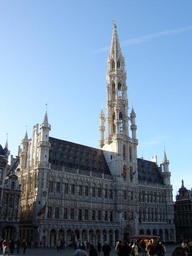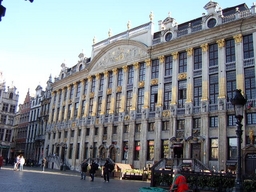The Grand-Place, the best-preserved medieval townscape in Europe and one of Europe’s most beautiful squares, is the unquestionable centre of Brussels.
A focus for tourists and locals alike, who come to admire its exquisite late seventeenth-century guildhouses and the Gothic magnificence of the Hôtel de Ville (Town Hall).
Originally marshland, the Grand-Place was drained in the 12th century. By 1350, the economic boom resulting from a flourishing cloth industry turned it into a covered market for bread, meat and textile which soon expanded beyond the boundaries of the square – hence the name of the narrow cobbled streets that surround it : rue au Beurre, rue des Bouchers, Marché aux Herbes, Marché aux Fromages…
The city’s merchants built their headquarters, the guildhouses, on the square. The Hôtel de Ville was added in the 15th century, adding a civic and political function to the square. It became a place where audiences were held, tournaments were organized, official decrees and pronouncements were read. In 1568, Philip II of Spain, a fervent Catholic, dispatched a massive army to crush the city’s Protestants, and thousands fled the city, leaving the others to starve as the economy collapsed.
It wasn’t until 1585, when the Habsburgs recaptured the town that the city’s economy revived and the Grand-Place resumed its role as a commercial centre.
Of the square’s original medieval buildings, however, only parts of the Hôtel de Ville and a couple of guildhouses survive today, the consequence of the 36-hour devastating bombardment by the troops of Louis XIV, which pretty much razed Brussels to the ground in 1695.
Unperturbed, the citizens swiftly rebuilt their headquarters,
creating a homogeneous Grand-Place, choosing to rebuild in a distinctive and flamboyant Baroque which made the square more ornate and more imposing than before. It has survived pretty much intact to this day.
Click here for a closer look at the various mansions composing the Grand-Place.


